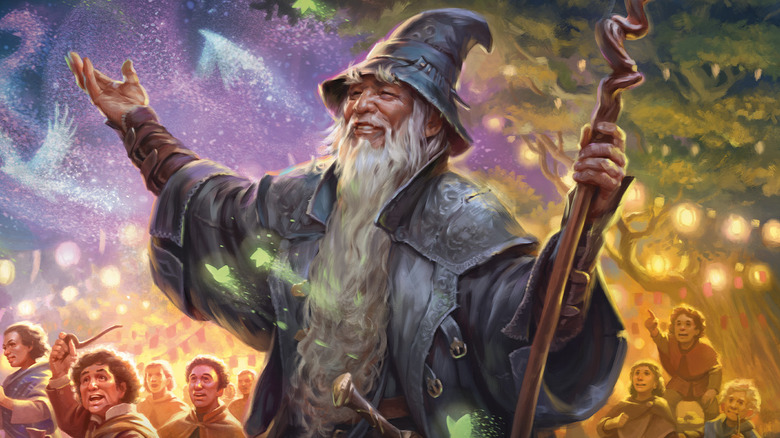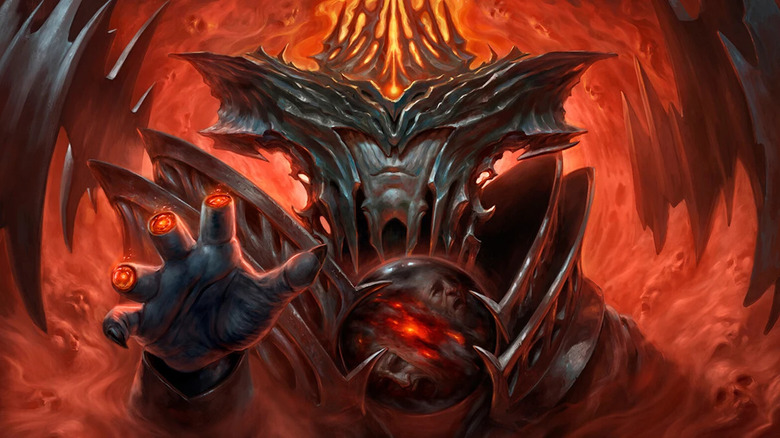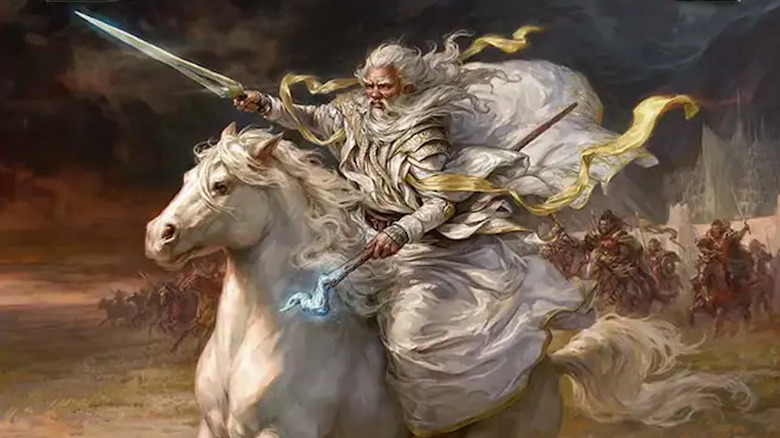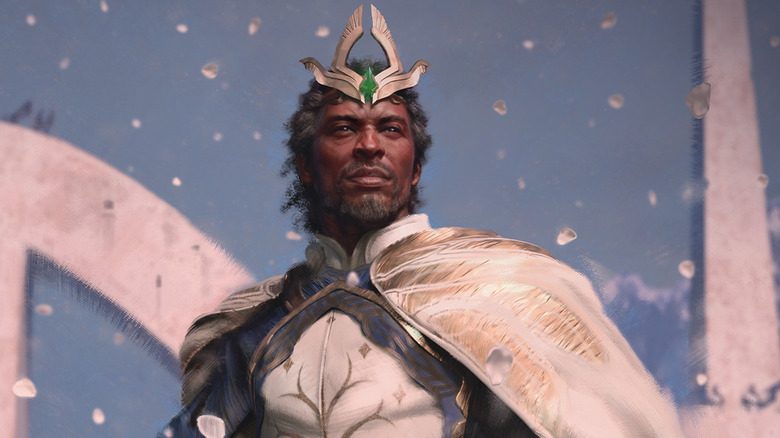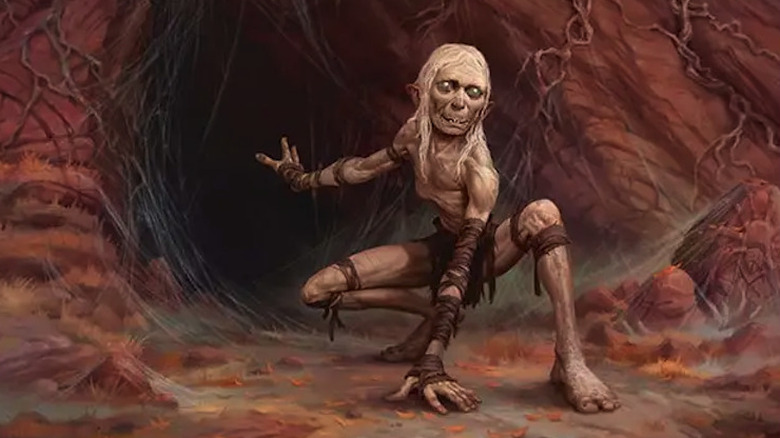Magic: The Gathering Reimagined These Iconic Lord Of The Rings Characters
As the twenty-year anniversaries of Peter Jackson's iconic "The Lord of the Rings" trilogy have played out in recent years, Middle-earth adaptations have become popular and prolific once again. Amazon Studios' "The Rings of Power" series is in full swing, and Warner Bros. is developing the first-ever Tolkien anime, "The War of the Rohirrim." LEGO released an epic Rivendell set not long ago, too, and a "Gollum" game recently made headlines, although admittedly for all the wrong reasons.
In the midst of this free-for-all, the popular card game label Magic: the Gathering released its own adaptation of Middle-earth in the form of its "The Lord of the Rings: Tales of Middle-earth" set. One card, in particular, quickly attracted global attention when the one-of-a-kind One Ring card was purchased by multiplatinum recording artist Post Malone for a cool $2 million.
Not to be overshadowed by the blockbuster card-collecting acquisition, despite its much lower price point, the rest of the Tales of Middle-earth set remains a beautiful addition to the MTG library. It's loaded with exquisite drawings and interesting iterations, many of which deviate from the look of the characters in both Jackson's films and Tolkien's writings. While adaptations are always artistic in nature, the degree of change incorporated into each piece is always fun to investigate. So, without further ado, let's explore how MTG reimagined some of Middle-earth's most iconic "Lord of the Rings" characters.
Sauron is wearing a palantir ...and missing multiple fingers
The Dark Lord Sauron is shown with a single lidless eye in the middle of a wild, wide helmet that covers the upper half of his face. A palantir is tucked into his armor, which is an interesting take (he does possess one of the seeing stones in the story, but it's never said that it's integrated directly into his apparel). The character is also shown with three fingers missing on his right hand, which is interesting as, in "The Two Towers" book, Gollum explains that "[Sauron] has only four [fingers] on the Black Hand." In Jackson's films, however, multiple fingers are cut off, and it appears the artist opted for the cinematic adaptation rather than the original in this case.
In an interview with GGrecon, Yigit Koroglu, the MTG artist and designer who brought the iconic villain to life, shed some light on the process of coming up with a new take on both Sauron and the countless other pieces of art for the set. "Wizards of the Coast has an amazing team of concept artists," Koroglu explained, adding, "As an illustrator, what I did was to take those concepts as starting points, and portray them in a way that the players would see a consistent world that they would like to be in (or not)." Koroglu also said, "What we tried to do was to have a modern take on Tolkien's work and still keep the epicness, and as a team." Balancing modern takes and classic epics is tough, and it steps on toes just as much as it invites others into the conversation, as the Tales of Middle Earth set's reception has proven — and not just with its depiction of Sauron, either ...
Gandalf has braided hair, a permanently glowing staff, and ...battle armor?
Gandalf is the most famous wizard in Tolkien's story. At various points in both the books and the movies, he's seen wearing a giant, wide-brimmed, pointed hat and either grey or white robes. This simple ensemble is taken to all-new levels with Magic: the Gathering's card art. First, there's the artist Dmitry Burmak's version of the wizard, where he's shown in Hobbiton attending Bilbo's 111th birthday bash. The amused magic wielder is dressed in a slimmer, bluish-gray wizard hat and is openly wearing a sword, as well as leather vambraces (forearm armor).
Other depictions show the White Wizard in all of his glory. In one image by artist Ekaterina Burmak, we see him with a wild, flowing beard that has a few braided tendrils below a menagerie of loose locks. He is in his white robes, but with distinct golden-yellow frills flapping in the wind. He's also depicted riding on Shadowfax while wearing plated battle armor. The various layers are woven into his flowing robes, giving it a very purposeful look. (i.e., he didn't toss this on right before the fighting started.)
In Tolkien's books, Gandalf's staff was plain and only emanated light in select moments, like in the Mines of Moria. In Peter Jackson's films, Gandalf's glowing stick and its random blue-jeweled insert became an iconic way the character was remembered. In MTG's artwork, the walking stick has become an ever-glowing appendage of the Wizard's wardrobe. The only exception is a lack of light in the Hobbiton shot. Other pictures consistently show the stick with a glowing blue top that looks like a puff of azure smoke.
The single characteristic that made the cut in the books, films, and card game? Gandalf has some hella bushy eyebrows, folks.
Aragorn is Black, tall, and sporting an important gem
One of the biggest deviations from traditionally accepted appearances is Magic: The Gathering's version of Aragorn. The character is portrayed as a Black man, a factor that predictably set the Tolkien community on fire once it was announced. Diverse casting has already been a point of contention for Amazon Studios' "The Rings of Power" series, and the toxic battle spilled right into the card game arena.
While purists condemned the change for not being faithful to Jackson's films as well as Tolkien's books, others pointed out that certain details, like skin color, aren't really clarified by the author. EarlyGame, for example, provided a breakdown of Tolkien's direct descriptions of Aragorn and his ancestors, the Men of Númenor, pointing out that skin color is rarely, if ever, mentioned in the descriptions of Human history in Middle-earth. This leaves enough room for interpretation for MTG's Aragorn to work for those open to artistic interpretation.
It's also worth pointing out that other details that are explicitly mentioned by Tolkien, such as the ranger's shaggy head of hair, his height, and his keen eyes, are all reflected in the artist Yongiae Choi's depiction of the Middle-earth king. Plus, in the picture at his coronation, he's shown wearing a green gem on his forehead. That would be the Elessar, a fabled Elfstone given to Aragorn by Galadriel in "The Fellowship of the Ring" book as a betrothal gift for his impending marriage to her granddaughter, Arwen. He identifies with the jewel so much that he is eventually called Elessar, the Elfstone of the House of Elendil.
Gollum is shown with a lot of hair ...and clothes
In Tolkien's descriptions, possessing the One Ring gives Gollum a thin, worn look, which both Peter Jackson and Magic The Gathering's art team channeled for their adaptations. However, artist Dmitry Burmak's Magic: The Gathering card deviates from the classic perception of Gollum in a couple of major ways.
First is the hair. MTG's Gollum is shown with a fairly healthy head of white hair. Andy Serkis' Gollum has almost no hair, just a few wisps. In "The Two Towers" book, Tolkien describes the wretch's hair using words like "thin" and "lank." These are subtle differences and certainly are not enough to make the MTG version inaccurate, but it's a deviation from the established norm, all the same.
And then there are the clothes. To start, we need to make something clear: Jackson's depiction of Gollum in a loin cloth is not accurate to Tolkien's vision of the character. On the contrary, in "The Hobbit," Gollum muses about what he keeps in his own pockets, implying that he has them in the first place, while he's described as having "ragged garments" in "The Two Towers." In an unpublished description of Gollum that Tolkien wrote for illustrators (which is referenced in "The Lord of the Rings: A Reader's Companion"), the author confirms that he is not naked and has pockets, doubtless getting new clothes over time, through theft or charity.
Nevertheless, the MTG card sticks with the near-naked approach, depicting the slimy creature in a frog-like stance, wearing a loin cloth. The biggest change of all? He has additional strips of fabric tied around various points on his arms and legs as if he's channeling his inner-'90s gothic youthfulness. It's an odd look and definitely a new one for the creepily beloved character.
